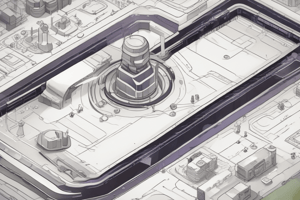Podcast
Questions and Answers
What is a key challenge that organizations may face when implementing Business Process Re-engineering (BPR) initiatives?
What is a key challenge that organizations may face when implementing Business Process Re-engineering (BPR) initiatives?
- Difficulty in reducing operational costs
- Enhancing customer satisfaction through personalized service
- Improving efficiency in a highly competitive market
- Cultural misalignment between the new processes and the organization's values (correct)
What is a primary benefit of Business Process Re-engineering (BPR) in terms of cost reduction?
What is a primary benefit of Business Process Re-engineering (BPR) in terms of cost reduction?
- Increasing revenue through process innovation
- Improving customer satisfaction through process redesign
- Reducing operational costs through process streamlining (correct)
- Enhancing organizational flexibility through process adaptation
What is a critical outcome of successful Business Process Re-engineering (BPR) initiatives in terms of quality enhancement?
What is a critical outcome of successful Business Process Re-engineering (BPR) initiatives in terms of quality enhancement?
- Enhancing organizational flexibility through process adaptation
- Increasing revenue through process redesign
- Reducing errors and defects through process standardization (correct)
- Improving customer satisfaction through process innovation
What is a key benefit of Business Process Re-engineering (BPR) in terms of customer service?
What is a key benefit of Business Process Re-engineering (BPR) in terms of customer service?
What is a key benefit of Business Process Re-engineering (BPR) in terms of strategic alignment?
What is a key benefit of Business Process Re-engineering (BPR) in terms of strategic alignment?
What is the primary focus of Business Process Re-engineering (BPR)?
What is the primary focus of Business Process Re-engineering (BPR)?
What is a characteristic of a business process?
What is a characteristic of a business process?
What is a potential outcome of a successful BPR implementation?
What is a potential outcome of a successful BPR implementation?
What percentage of BPR initiatives may fail to achieve their intended results?
What percentage of BPR initiatives may fail to achieve their intended results?
What is the nature of Business Process Re-engineering?
What is the nature of Business Process Re-engineering?
What is a primary advantage of Business Process Re-engineering (BPR) in terms of employee empowerment?
What is a primary advantage of Business Process Re-engineering (BPR) in terms of employee empowerment?
What is a common reason for organizational resistance to BPR?
What is a common reason for organizational resistance to BPR?
What is the primary reason why many Business Process Reengineering (BPR) attempts fail?
What is the primary reason why many Business Process Reengineering (BPR) attempts fail?
What is the main difference between Business Process Reengineering (BPR) and Total Quality Management (TQM)?
What is the main difference between Business Process Reengineering (BPR) and Total Quality Management (TQM)?
What is the primary outcome of Business Process Re-engineering in an organization?
What is the primary outcome of Business Process Re-engineering in an organization?
What is a potential consequence of inadequate planning and lack of clear objectives in BPR?
What is a potential consequence of inadequate planning and lack of clear objectives in BPR?
What is the first step in Business Process Re-engineering?
What is the first step in Business Process Re-engineering?
What is the primary goal of re-engineering in an organization?
What is the primary goal of re-engineering in an organization?
What is a critical factor in ensuring the success of BPR initiatives?
What is a critical factor in ensuring the success of BPR initiatives?
What is the primary purpose of process mapping and flowcharting in BPR?
What is the primary purpose of process mapping and flowcharting in BPR?
What is a potential consequence of BPR's overemphasis on technology?
What is a potential consequence of BPR's overemphasis on technology?
What is one of the advantages of Business Process Reengineering (BPR) in terms of customer service?
What is one of the advantages of Business Process Reengineering (BPR) in terms of customer service?
What is one of the benefits of Business Process Reengineering (BPR) in terms of competitiveness?
What is one of the benefits of Business Process Reengineering (BPR) in terms of competitiveness?
What is the outcome of fostering a culture of continuous improvement and innovation in an organization?
What is the outcome of fostering a culture of continuous improvement and innovation in an organization?
What is the primary focus of the new process design in BPR?
What is the primary focus of the new process design in BPR?
What is the primary goal of organizational re-engineering?
What is the primary goal of organizational re-engineering?
What is the role of technology in Business Process Re-engineering (BPR)?
What is the role of technology in Business Process Re-engineering (BPR)?
What is a key characteristic of Business Process Re-engineering (BPR)?
What is a key characteristic of Business Process Re-engineering (BPR)?
What is the purpose of continuous monitoring and evaluation in BPR?
What is the purpose of continuous monitoring and evaluation in BPR?
What is a key distinction between BPR and incremental improvement?
What is a key distinction between BPR and incremental improvement?
What is the primary objective of Business Process Re-engineering (BPR)?
What is the primary objective of Business Process Re-engineering (BPR)?
What is the nature of Business Process Re-engineering (BPR)?
What is the nature of Business Process Re-engineering (BPR)?
What is the relationship between Business Process Re-engineering (BPR) and organizational strategy?
What is the relationship between Business Process Re-engineering (BPR) and organizational strategy?
What is the focus of Business Process Re-engineering (BPR) in terms of costs?
What is the focus of Business Process Re-engineering (BPR) in terms of costs?
What is the outcome of a successful Business Process Re-engineering (BPR) initiative?
What is the outcome of a successful Business Process Re-engineering (BPR) initiative?
What is the primary benefit of Business Process Re-engineering (BPR) in terms of quality?
What is the primary benefit of Business Process Re-engineering (BPR) in terms of quality?
What is the nature of a Business Process Re-engineering (BPR) initiative in terms of time?
What is the nature of a Business Process Re-engineering (BPR) initiative in terms of time?
What is the relationship between Business Process Re-engineering (BPR) and innovation?
What is the relationship between Business Process Re-engineering (BPR) and innovation?
What is the primary goal of Business Process Re-engineering (BPR) in terms of speed?
What is the primary goal of Business Process Re-engineering (BPR) in terms of speed?
What is the outcome of a Business Process Re-engineering (BPR) initiative in terms of customer satisfaction?
What is the outcome of a Business Process Re-engineering (BPR) initiative in terms of customer satisfaction?
Flashcards are hidden until you start studying
Study Notes
Business Process Re-engineering (BPR)
- Definition: The radical redesign of business processes to achieve dramatic improvements in performance, efficiency, and effectiveness.
- Focuses on optimizing end-to-end processes and eliminating redundancies.
Key Characteristics of BPR
- Radical changes to business processes to achieve significant improvements
- Focus on optimizing end-to-end processes and eliminating redundancies
- Continuous journey of innovation and optimization
Benefits of BPR
- Cost reduction: elimination of redundancies, efficient resource utilization, and improved efficiency
- Enhanced quality: error reduction, standardization, and improved customer service
- Greater flexibility: adaptability to change, scalability, and innovation
- Competitive advantage: market differentiation, innovation, and strategic alignment
- Employee satisfaction: role clarity, empowerment, and increased productivity
- Risk management: reduced operational risks, improved compliance, and better alignment with business goals
Disadvantages of BPR
- Organization resistance: fear of change, concerns about job security, and discomfort with new technologies or processes
- High initial costs: investment in new technologies, training programs, and consulting services
- Risk of implementation failure: inadequate planning, lack of clear objectives, and integration problems with existing systems
- Human factors: changes to job roles, responsibilities, and employee morale
- Overemphasis on technology: neglect of human and organizational factors
- Short-term disruption: temporary declines in efficiency and productivity
- Cultural misalignment: clash with existing organizational culture
Importance and Benefits of BPR
- Enables organizations to adapt to changing business environments and maintain competitive advantage
- Cost reduction, efficiency improvements, and quality enhancement
- Improved customer service, flexibility, and strategic alignment
- Fosters a culture of continuous improvement and innovation
Steps Involved in BPR
- Develop a business vision and objectives
- Identify business processes to be re-engineered
- Understand and analyze existing processes
- Identify change levers and enablers
- Design the new process
- Develop a transition plan
- Implement the re-engineered process
- Monitor and evaluate the new process
- Continuous improvement
Organizational Re-engineering
- Definition: A comprehensive, transformative approach to fundamentally redesigning the way an organization operates
- Key concepts: fundamental rethinking, radical redesign, and dramatic improvements
- Aims to achieve significant performance improvements in efficiency, effectiveness, and competitiveness### Re-engineering Goals and Principles
- Re-engineering aims to deliver substantial, measurable benefits to the organization.
What Re-engineering is Not
- Incremental improvement: BPR involves a complete rethinking and restructuring of how work is done, rather than making small adjustments to existing processes.
- Quick fix or short-term solution: BPR is a strategic initiative aimed at achieving long-lasting improvements in efficiency, quality, and competitiveness.
- Focused solely on technology: BPR involves aligning technology with redesigned processes to achieve strategic goals, rather than just adopting new technologies.
- Ignoring human factors: BPR involves addressing human factors such as organizational culture, employee skills, and change management.
- One-size-fits-all approach: BPR requires customization and adaptation to fit the specific context, goals, and challenges of each organization.
- Solely cost-cutting exercise: BPR aims to improve overall organizational performance across multiple dimensions, including quality, speed, customer satisfaction, and innovation.
- Static and one-time effort: BPR is an ongoing process of continuous improvement and adaptation to changing business environments.
- Entirely separate from strategy: BPR should be closely aligned with the strategic objectives and vision of the organization, driven by strategic goals to enhance the organization's ability to achieve its long-term vision.
Studying That Suits You
Use AI to generate personalized quizzes and flashcards to suit your learning preferences.





